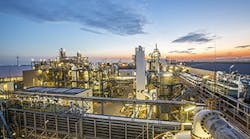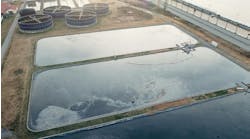The quest by chemical companies to meet targets for renewable electricity use is opening up business opportunities and fostering new relationships with both producers in other energy intensive industries and electricity suppliers.
Two Dutch companies, Nouryon (formerly AkzoNobel Specialty Chemicals), Amsterdam, and Royal DSM, Sittard, exemplify what’s possible.
“Our business is very energy intensive so we decided a long time ago on the decarbonization of our energy portfolio and that led us to a high share of renewables. This has built over the last ten years and, globally, over 45% of our energy now comes from renewable sources,” explains Marcel Galjee, energy director industrial chemicals for Nouryon. “This decarbonization of our energy portfolio gives us opportunities to be less dependent on carbon prices and at the same time lower our costs,” he adds.
It also affords the company an opening into new areas for growth such as green molecules, via, for example, green hydrogen initiatives it’s involved with. “So the question for us is how to use renewable electricity to make green hydrogen and from there to make bio-based and circular molecules,” he says.
One such initiative involves a partnership with forestry groups and a materials company in Sweden to explore the opportunities for producing both green hydrogen and electrofuels (synthetic fuels based on electricity, water and carbon dioxide) using renewable electricity.
Converting excess renewable electricity into green hydrogen or electrofuels offers the potential to balance the fluctuations in supply and demand of electricity from renewable sources including wind and solar power. Nouryon is a major user of electricity in Sweden and is contributing its expertise in electrochemistry to the partnership.
The electrolysis of water, which yields hydrogen and oxygen, underpins the electrofuels concept. It, when combined with carbon dioxide, can produce methanol, for example. In this way, the process serves as a carbon sink by effectively recycling carbon dioxide emissions.
“This study is progressing really well; there’s a lot of momentum on circular chemistry and green hydrogen in Sweden and also in other regions in the world,” comments Galjee.
Even so, scaling up of green hydrogen technology to reduce costs is a pressing need. Nouryon currently has Europe’s largest water electrolysis facility, a 10-MW unit in Norway, as well as hydrogen-producing chlor-alkai plants in The Netherlands (Figure 1) and Germany. Taking the technology to the 100-MW level and beyond will require the whole industry to work together with technology providers and supply chains, he emphasizes.
Figure 1. Chlor-alkali complex in Rotterdam generates hydrogen. Source: Nouryon.
“However, if we are serious about meeting carbon emission targets as set in the Paris agreement, then just adding electricity from wind and solar power is not enough; the complexity is in decarbonizing the entire product,” he insists.
Nouryon now is involved with gas transport and storage company Gasunie, Groningen, The Netherlands, in a study investigating the possible conversion of sustainable electricity into green hydrogen using a 20-MW water electrolysis unit in Delfzijl, The Netherlands. The idea here is that such a facility would supply hydrogen to BioMCN, Delfzijl, to produce renewable methanol in a way that reduces carbon dioxide emissions by up to 27,000 mt/y compared to fossil-fuel-based production.
“We intend to take the final investment decision for this project in early 2020; the most important technical challenge of the 20-MW electrolyzer project is to scale up and reach the right level of cost-effectiveness and efficiency for the electrolyzers,” Galjee notes.
In another effort, Nouryon has joined with Tata Steel and the Port of Amsterdam to assess the feasibility of a large green hydrogen cluster in the Amsterdam region. The three are studying a 100-MW water electrolysis facility to produce up to 15,000 mt/y of hydrogen as well as oxygen at Tata Steel’s Ijmuiden site. By using renewable electricity, the initial unit will avoid up to 350,000 mt/y of carbon dioxide emissions. A final investment decision is expected in 2021 and, if the project gets approved, the partner companies hope to scale up the technology even more.
Nouryon will operate the facility; Tata Steel will take the oxygen to further enhance the sustainability of its production processes. The parties jointly will explore different routes to use hydrogen for turning steel mill emissions into useful chemicals and products. The Port of Amsterdam will focus on the infrastructure for broader distribution of green hydrogen, to support both development of new industries and zero-emission transport in the area.
“What is different in the energy sector now is that the need for flexibility has increased dramatically. So we as an industry have to think differently, too. Although we are energy intensive, can we be flexible in our processes in a way that helps us lower the cost of electricity while both helping the grid and maximizing our usage when and where the energy is available? The Tata Steel project is a good example of this: the power is consumed right where it comes ashore and so reduces connectivity and transmission costs. It shows that by working together we can create value and create efficiency gains,” stresses Galjee.
Another example is Nouryon’s contract with energy company Vattenfall to supply 1.25 TWh/y of renewable electricity to seven facilities in Sweden and Finland. By 2020, those facilities will get 100% of their electricity from renewable sources.
“This is a really good example of how two companies with very different roles in the value chain can come together. Vattenfall will build the large wind parks needed to supply the renewable electricity — we aren’t in the business of building and operating our own wind parks.”
A further initiative is the green energy purchasing consortium with Google, Philips and Royal DSM in The Netherlands. The four companies take renewable electricity directly from two Dutch wind farms — Krammer and Bouwdokken — that together have a generating capacity exceeding 140 MW.
“This is a very nice example of how sustainability leaders from different energy intensive industries are eagerly looking for opportunities to develop their portfolios and get access to renewable power. It’s up and running, which shows that it works and creates value. It has also raised the attention of a lot of other companies. We could expand this to other regions to have the ability to decarbonize in all regions where we operate,” notes Galjee.
“Overall, what we are showing by connecting different energy intensive industries together is that at the same time as decarbonizing you can create really new value chains and new business opportunities,” he concludes.
Local Initiative
Another enthusiast for the green energy consortium approach is Sim van der Linde, project director for renewable energy at Royal DSM.
“It’s a very cool project, although we had to put quite some effort in at the beginning. Initially, we spoke with more energy-intensive companies, but the four who are now involved have the same mindset and momentum as Royal DSM when it comes to sustainability and renewable electricity use,” he says.
The project is a local initiative, driven by citizen cooperatives, emphasizes Van der Linde. In fact, the consortium’s signing of long-term power purchase agreements (PPAs) in October 2016 and January 2017 allowed the cooperatives to access the funding needed to start constructing the two wind farms. The final turbine, at Krammer (Figure 2), recently was commissioned.
Figure 2. Members of green energy purchasing consortium get energy from this wind farm in southwest Holland. Source: Royal DSM.
Matching electricity supply to demand is crucial; so the consortium has hired Kinetic Energy Kinas, Bergen, Norway, to predict availability 24 hours in advance and then manage the intraday imbalances. Van der Linde notes that this gives consortium members three options to access their renewable electricity: take it “as is” as the wind blows; sell it to the market as “grey electricity” while keeping the guarantees of origin; and modifying the wind profile in baseload blocks that are incorporated into the supply portfolio to DSM.
Prior to the Paris agreement in 2015, Royal DSM already had started to create a portfolio of renewable energy initiatives. “At that point, we did not record how much renewable electricity we used. So a target was set for us to be purchasing 50% of our electricity from renewable sources by 2025 — and this has recently been extended to 75% by 2030. Over the last year, we have reached 41%, which makes us confident that we will achieve our new target ahead of time,” comments van der Linde.
“As a company, Royal DSM really understands and embraces sustainability as a growth driver and, in fact, I’m ambitious to speed up the realization of our targets. Our confidence is growing that we can do this following the success of a number of projects,” he adds.
For instance, the company signed an agreement with Dutch energy supplier Eneco, Rotterdam, which currently generates more that 1GW/y of sustainable energy from a variety of sources including onshore and offshore wind farms, a biomass plant and numerous solar farms in several European countries. For Royal DSM, the deal ensures that 100% of the electricity it purchases in The Netherlands now comes from renewable sources.
Meanwhile, at the end of 2017, Royal DSM signed its first PPA in the U.S. — with NextEra Energy Resources, Minco, Okla., for 128,000 MWh/y from the Minco IV wind energy center. That project, which was fully commissioned earlier this year, now accounts for about 40% of Royal DSM’s electricity use in the U.S.
“Our focus is not directly on specific carbon reduction numbers, rather on purchasing increasing volumes of renewable electricity with carbon reduction as a result. We also favor additionality, meaning that we conclude contracts to be supplied from new assets for renewable electricity that have yet to be built,” says van der Linde.
That’s an important point because the company is actively expanding its business in the U.S. and so needs new supplies of renewable electricity to be available to meet its targets.
Both Nouryon and Royal DSM are members of RE100 (www.there100.org), an initiative bringing together companies around the world committed to using 100% renewable power. That group now includes 169 companies after 3M, Maplewood, Minn., joined in February.
3M has committed to source 100% renewable electricity for its global operations by 2050, with an interim goal of 50% by 2025. In making the announcement about joining Re100, 3M noted that its worldwide headquarters campus in Minnesota would now fully rely on renewable power — bringing its current global level of renewable energy sourcing to 30%. The campus will get power from Xcel Energy wind farms located near Pipestone, Minn.
Storing Renewable Electricity
A challenge for all generators and users of renewable electricity is how to store any surplus.
One way is to use chemical energy carriers and, in March, the German Research Foundation (DFG), Berlin, launched a priority research program “catalysts and reactors under dynamic conditions for energy storage and conversion” (DynaKat) to investigate them. The DFG already has committed to investing €8.5 million ($9.6 million) in the first three years of the expected six-year program.
The 12 research consortia involved will investigate how chemicals can store excess electricity from wind and photovoltaic facilities in such a way to either make electric power available again or use the chemicals themselves as sustainable feedstocks for the production of fuels or platform molecules for the chemical industry.
Catalysts, electrochemical cells and reactors are needed for the conversion of carbon dioxide or hydrogen into energy-storage molecules such as methane, hydrocarbons, or alcohols. “However, the influence of dynamic external conditions on catalytic reaction systems, for example caused by fluctuating wind and solar power, has hardly been studied so far. But we know that the structure of solid catalysts and, hence, their catalytic activity can vary considerably under changing reaction conditions,” says professor Jan-Dierk Grunwaldt of the Karlruhe Institute of Technology (KIT).
The plan is to study every aspect of the processes involved, from the atomic level of the catalyst to the spatial distribution of feed concentrations and temperature variations on the reactor level.





